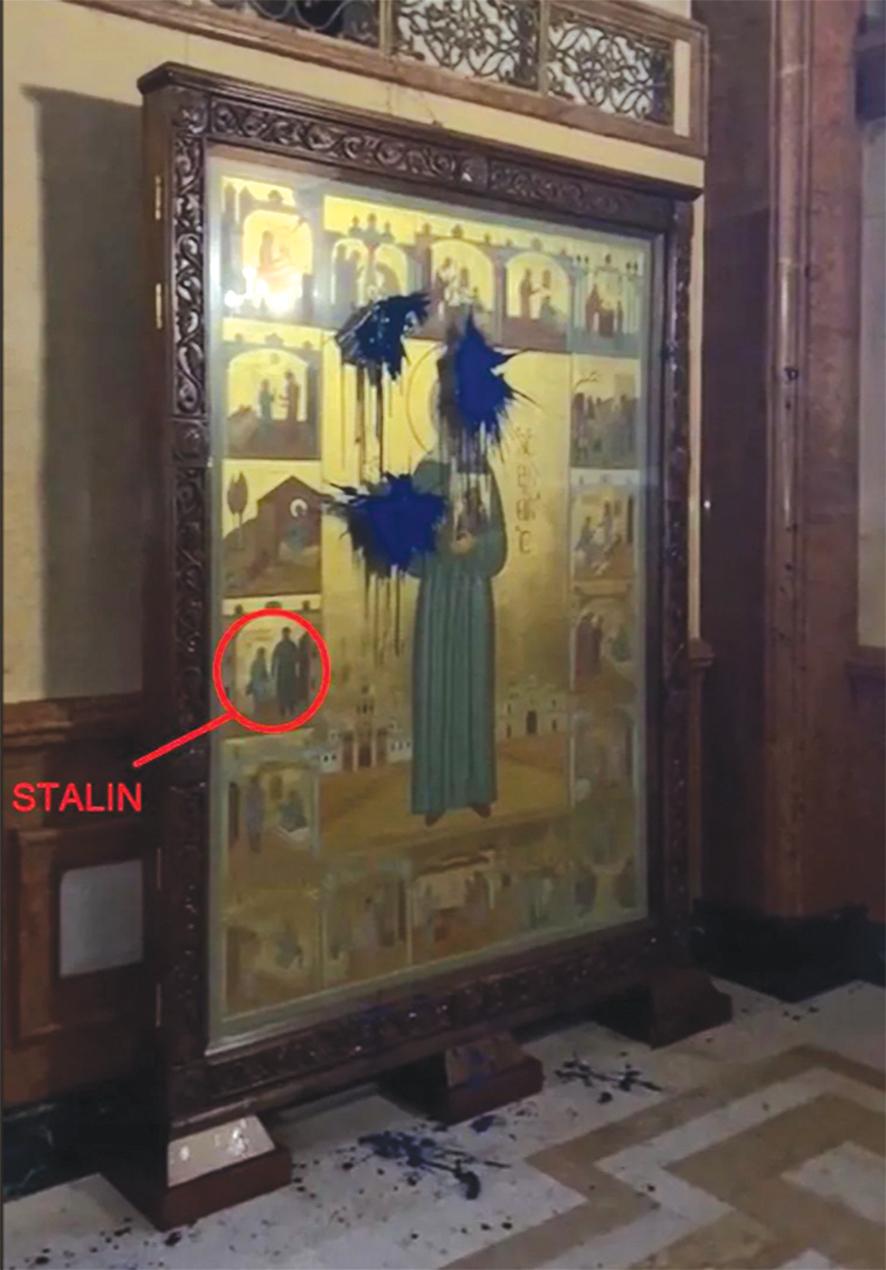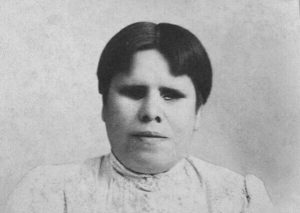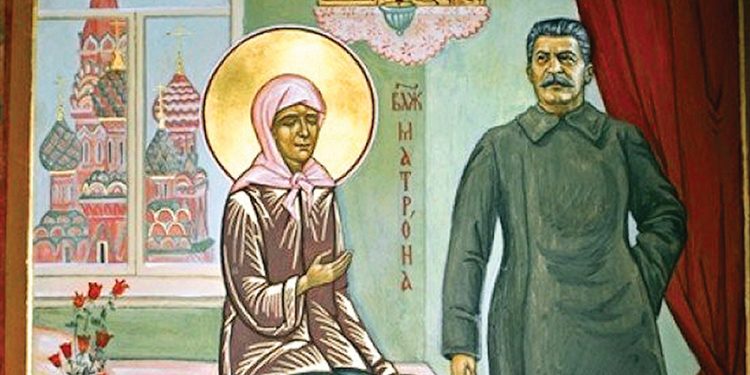A scandal has been growing in Georgia this past week over an icon discovered in Tbilisi’s main cathedral, Holy Trinity (Sameba), which depicts the Russian Saint Matrona of Moscow seated beside Soviet dictator Joseph Stalin, a man who ordered the extermination of tens of millions of people in the 1930s and 1940s.
Footage of the icon in Sameba was first shared on Saturday by Ilia Chigladze, a Georgian archpriest, on Facebook. Soon after, Giorgi Kandelaki, a member of the opposition European Georgia party and a researcher at the Soviet Past Research Laboratory, also shot and shared photos of the icon on social media.
The icon depicts Saint Matrona of Moscow, a 20th-century Russian Orthodox Church saint sitting beside a standing man who both Chigladze and Kandelaki claimed to be Joseph Stalin, the Georgian-born dictator and leader of the Soviet Union.
Among a wave of negative reaction to the icon among Georgians on social media, the Polish Embassy in Tbilisi shared the photo of the icon on its Facebook page with the following note in Georgian and Polish: “The Polish Institute of National Remembrance estimated the total number of Polish citizens who fell victim to the Soviet regime at 1.8 million. Of this, 150,000 lost their lives. Most of these victims were people repressed in the years 1939-1941, when the repression affected approximately 1.6 million people. The remaining 200,000 are people subjected to repression from 1944 to 1952. Research is still ongoing.”
In an interview with Tabula on Saturday, Andria Jagmaidze, the head of the Patriarchate’s public relations department, did not deny that Stalin was depicted in the icon, but stated that the icon was dedicated to Matrona, and not the Soviet leader.
“If, somewhere on the fresco of St. George, [the Roman Emperor] Diocletian is depicted, this does not make it an icon of Diocletian,” he said, going on to claim that the controversy surrounding the Matrona icon had been ignited to deliberately overshadow the celebration of Orthodox Christmas on 7 January.
Archimandrite Ioane Mchedlishvili of the Holy Trinity Cathedral stated on Sunday that the icon had been in the cathedral “for several months” already. The same day, Gocha Barnov, a theologian, told TV channel Mtavari Arkhi that the icon’s presence in the cathedral was ‘blasphemous’ and that it should be “removed immediately.”
The following day, Davit Tarkhan-Mouravi, the leader of the conservative Alliance of Patriots party, announced that he had donated the icon to the cathedral himself, and that the icon recognized the fact that Stalin had met Matrona for counsel during World War II.
In a 2021 publication commissioned by the Netherlands Institute for Multiparty Democracy titled “13 Myths about Stalin,” the Eastern European Center for Multiparty Democracy found that Russian President Vladimir Putin’s regime has actively been trying to portray Stalin as a ‘religious man,’ despite the Soviet authorities’ mass arrest of worshippers and demolition or destruction of churches and other religious buildings during Stalin’s time in power. Indeed, in a recent study carried out by Guram lursmanashvili of the Sulkhan-Saba Orbeliani University, it was noted that Georgians of the soviet generation tend to view Stalin as a religious man due to his Georgian nationality (“He was Georgian, so he must have been Christian,” a 56-year-old Georgian respondent stated), as well as his early-life attendance of the Tbilisi Seminary. Yet, seminarist and Stalin’s comrade Philip Makharadze once wrote, “No secular school produced as many atheists as the Tiflis Seminary.”
Mythdetector.ge claims that the meeting between Stalin and Saint Matrona has not been historically confirmed and is “only a legend,” a fact they say was established by Archimandrite Job Gumerov, who was assigned to look into the history of Saint Matrona so that she could be canonized. The legend states that, in 1941, Stalin met with Matrona Nikonova, and on her advice had the icon of the Mother of God taken to the front line, which is what protected the USSR from the fascists.

Media outlet Obiektivi this week shared a video of Irma Inashvili, leader of the Alliance of Patriots of Georgia party, in which she discusses the supposed meeting between Stalin and Matrona. She highlights in her video that depicting negative figures on icons is a common practice.
“…a conversation between Holy Matrona and Stalin took place, and then the Icon of the Mother of God was displayed, which helped the fighters against fascism in these positional battles, and then the opponents of fascism achieved a number of successes. This concept is depicted [in the icon],” Inashvili said. “…Why is the dragon depicted on the icon of St. George, i.e. the devil, and why are real devils depicted on icons? Let’s turn it all around, change the iconography school, then.”
The Patriarchate of Georgia released the following statement on the icon: “Since Stalin’s meeting with St. Matrona, due to insufficient evidence, is not included in the canonical text of his life, it is not recognized by the Russian Church, which has conducted special research into the matter. As such, we appeal to the donor to make the appropriate changes to the icon himself, or we will do so.”
The icon of Saint Matrona in question, with the image of Stalin beside her, was created by Ilya Pivnik in 2008. The display of the icon in St. Petersburg likewise resulted in protests from the people there. The head of the St. Petersburg Diocese blamed the media for generating such a story around the icon and sent the icon to Moscow so that the scandal would end and the icon would not be damaged by “liberal extremists.”
In Georgia, though, the icon received no such protection, and since release of the news of the icon’s placement in the Holy Trinity Cathedral, it has had paint thrown at it.
Civil activist Nata Peradze posted a video on her Facebook page this week showing the paint-damaged icon of Matrona, leading to members of the far-right Alt-Info group beginning a rally on the street outside her home in downtown Tbilisi in protest.
Police had to block off the road leading to the residential area to prevent the mob from reaching the building in which Peradze lives. The Ministry of Internal Affairs said that law enforcers were in attendance “to protect public order,” and called on the protesters to act within the Law on Freedom of Expression and Public Assembly. They eventually dispersed, promising to rally again, this time outside Parliament, after the Old New Year festivities are over.
Meanwhile, an investigation was launched into the damaging of the icon of Matrona under Article 166 of the Administrative Offences Code, which pertains to petty hooliganism. Georgian Dream party member and lawyer Anri Okhanashvili on Thursday told journalists: “We are initiating amendments in the next few days calling for stricter criminal liability for damage to religious premises and property.”
Who was Saint Matrona?

Matrona Dmitrievna Nikonova (1885 – 1952) is a canonized saint of the Russian Orthodox Church who is said to have been born with the gifts of prophecy, spiritual vision, and healing. Her impoverished parents were planning to place their child in an orphanage after birth, but her mother changed her mind after she dreamed of a white bird of divine beauty with empty eye sockets landing on her breast. When Matrona was born blind, with eyelids closed over empty eye sockets, her mother took it as a heavenly sign and kept her. It is said that by the time she was eight, she had already revealed prophetic and healing powers.
The Russian Revolution of 1917 led Matrona to travel in search of work and food, and in 1925, she moved to Moscow. Staying with friends and relatives in various apartments and basements, she gained a reputation as one who could be turned to for godly advice. Preaching the Russian Orthodox faith, she was not popular with the Communists, and yet, unlike the majority of religious people who were sent to the Gulag or into exile for their beliefs, she was not, as none who knew her would give up her location.
Such was the people’s veneration of her “holy” powers, many years after her death she was canonized by the Russian Orthodox Church. Her remains were placed in the Church of the Protecting Veil of Our Lady at the Intercession Convent in Moscow, and attract thousands of pilgrims to visit each year seeking her aid from beyond the grave.
Her day is commemorated by the Orthodox Church on May 2.
By Team GT














